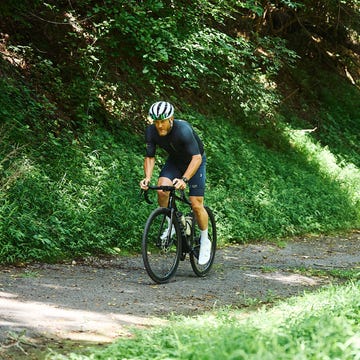The Takeaway: The Pinarello Dogma X is a versatile bike. It features a mid-endurance fit, aerodynamic frame, and generous tire clearance, making it suitable for long, comfortable rides. The bike is very fast, yet emphasizes rider comfort and stable handling, while retaining the brand's distinctive design aesthetic.
Dogma X—What You Need to Know
Price as tested: $15,500 (Dura Ace Di2 w/ Princeton Grit 4540)
Weight as tested: 16.2 lb. (size 530)
Sizes offered: 430, 465, 500, 515, 530, 540, 550, 560, 575, 595, 620
Weight limit: 264.5 lbs. / 120 kg.
Model price range: $15,500 to $16,000
Frame only?: Yes, $6,950
Max tire clearance: 35mm
Drivetrain: 1x or 2x, electronic only
Routing: Internal
Bottom Bracket: Italian threaded
Seatpost: Frame-specific D-shaped, 5mm, and 20 mm offsets offered
Derailleur Hanger: frame specific
Warranty: Two years, expanded to five if frame is registered with Pinarello within 30 days of purchase.
Crash Replacement Program: If frame is registered with Pinarello within 30 days of purchase, Pinarello offers “Impact Replacement Program discount” coverage for five years
Unquestionably Pinarello
While sharing similar aerodynamic profiles, the F serves as the brand's pure race bike, whereas the X is engineered for enhanced comfort and versatility across varied surfaces.
These distinct purposes manifest in several key differences: The Dogma X offers greater tire clearance (35 VS. 30mm), emphasizes vertical compliance, features a slightly more relaxed fit, and delivers more stable handling through its extended wheelbase and modified steering geometry.
The Dogma X and Dogma F both showcase Pinarello's distinctive frame design aesthetic. Based on extensive experience testing various bike designs and features, much of the visual drama appears driven by brand identity rather than pure function.
Regarding the seat stay design, Pinarello states: "Our X-Stays incorporate precisely selected carbon fiber layup patterns and reduced-diameter curved top stays. This configuration dampens vibrations while maintaining lateral stiffness to offset the lengthened chain stays. The doubled attachment points disperse forces across two areas of the seat tube, further minimizing vibration transfer to the rider."
What I find a counterintuitive—based on what I’ve been told about frame design and construction—is that Pinarello says all this added bracing—which adds an additional triangle and effectively reduces the size of the rear triangle—somehow both adds stiffness and makes the bike ride more smoothly.
I’m reasonably certain Pinarello could make the Dogma X feel and perform the same with as it does with a simpler frame design. But then the Dogma X would would look like a lot of other bikes and not a Pinarello.
It Doesn’t Fit Like A Typical Endurance Bike
The usual makeup of a brand's tarmac-oriented drop-bar line is one race bike and one endurance bike. The race bike's fit is low and long, while the endurance bike, in the same size, gets less aggressive fit dimensions (reach and stack), which provide a more upright riding position.
My pasted table illustrates what I'm talking about. On the right side are Trek's Domane (endurance) and Madone (race), which highlights the typical approach. The Domane's stack is 30mm taller, and the reach is 10mm shorter than the Madone's.
Pinarello also offers endurance bikes with a less aggressive fit than its race bike. In the middle of my table is the Pinarello X (just X, no Dogma). Like Trek's Domane, the Pinarello X has a one-centimeter shorter reach and over 30mm taller stack than the brand's race bike.
But Pinarello does something slightly different with its Dogma X endurance bike. While the reach and stack are shorter and taller than the brand's Dogma F race bike, the difference is less dramatic than usual. The Dogma X's stack is 16mm taller, and reach is four millimeters shorter than the Dogma F's. That's half the difference of the Dogma F to Pinarello X change.
This mid-endurance fit seems to be gaining popularity. In my second chart, I've listed the Dogma X alongside some newer endurance (AKA all-road) style bikes like Bicycling's Bike of the Year Envy Fray, the Cervélo Caledonia 5, and FiftyOne's Sika. These bikes also offer a more aggressive fit than a traditional endurance bike (examples on the right side of the table), but they're not as long and low as a race bike. Plus, they have great tire clearance, an emphasis on rider comfort, and (for all but the FiftyOne) aerodynamic tube shaping.
Personally, I couldn't be happier. I love the tire clearance, comfort focus, and the mellower handling of an endurance bike, but I find the typical endurance bike fit in my size too tall and short—and that's not comfortable for me.
That's because taller and shorter isn't universally more comfortable for all riders than longer and lower. But longer and lower shouldn't be relegated only to race bikes with aggressive handling and limited tire clearance.
Plus, we're also seeing evidence that as long and low as possible isn't necessarily more aerodynamic and efficient.
It's the Dogma X's recipe of fit, handling, and features (generous tire clearance and aerodynamic tube shapes) that makes it (and the Fray and Caledonia-5) so compelling. It's a perfect bike for long, fast, and comfortable rides on pavement, and some not-pavement too.
Finally, I'd like to give a hearty high-five to Pinarello for offering the Dogma X in 11 sizes, far more than other brands offer. More sizes let more riders get a precise fit.
How Much is Dogma Worth?
Because the Dogma X is somewhat low and long, it may not be a great choice if your fit needs require a shorter and taller frame.
I've spoken to one Pinarello dealer (who wishes to remain anonymous so as not to complicate their relationship with the brand), who said they feel the Dogma X's geometry is too aggressive for its target audience.
When I said that the Pinarello X exists to serve riders who need something shorter and taller than the Dogma X, this dealer countered that the X isn't a Dogma X, and their customers want Pinarello's best.
Admittedly, "I'm grumpy because the fanciest bike doesn't fit me as well as the slightly less fancy bike" is decidedly a rich person's problem. But the Dogma X does float in a liminal space that's not race and not quite endurance. And it's uncertain if that space is the future of road bikes, or if the Dogma X is an example of the transition taking us to where drop-bar bikes are heading.
Photo Gallery
A Masterpiece for Long and Comfortable Rides
I went through the same progression of feelings with the Dogma X that I've gone through with other Pinarello review bikes.
I pull it out of the box and shake my head at all the flourish and excess. Then I weigh it and get a little grumpy because they are heavier than they should be, given the price of the bike and the build kit.
But just like all the Dogmas I've ridden and reviewed (all the way back to the fantastic magnesium Dogma), as soon as I started riding the Dogma X, all the negative vibes were blasted away because it's Such. A. Damn. Good. Bike.
It's no race bike, but it is far more fierce than the average endurance bike. It's snappy and quick, it lunges when you stamp down on the pedals, with direct-feeling steering and precise handling.
Historically, Pinarello's race bikes have featured handling that is more carve-y than darty, with more high-speed stability than other brands' race bikes. Ride the challenging descents in the mountains north of Pinarello's Treviso base, and you quickly understand why.
The Dogma X is even more composed than the Dogma F. At high speeds, it is calm and tracks straight with little effort, but the composure is most noticeable when being buffeted by crosswinds and riding over uneven and broken tarmac. Off pavement, it dances down dirt roads, confidently tracking over bumps and steering predictably when traction is sparse.
The slight downside to this composure is that the Dogma X doesn't flick side to side with as light a touch as a quicker-handling bike. Making the bike initiate a turn, and making mid-corner corrections, takes a bit more effort. You can notice the extra heaviness in the bars as you navigate a turn with a changing radius, or snake through a chicane.
To be clear, the Dogma X's steering is not slow or sluggish, but the extra weight in the bars makes the handling feel more tactile than telepathic.
Which I think is good. The light steering and aggressive handling of a race bike is widely seen as the ideal. I don't think it should be. In the context of competition, this handling paradigm has its place, but if you're not riding for a paycheck and to keep your sponsors happy, why deal with the mercurial nature of a race bike?
Handling like the Dogma X's is more user-friendly. Not so much 15 minutes into a ride, but five hours into a ride, you really appreciate its calm nature.
Rider comfort is another one of the Dogma X's strengths, and, like the handling, pays ever larger benefits as the time and distance of a ride grow.
Maybe all that hoopla about the tubing explosion at the junction of the seat stays and seat tube is true, because seated comfort is superb, with no perceptible tradeoff in frame stiffness and pedaling efficiency.
The front end isn't quite as supple as the rear of the Dogma X, but it does a good job of taking the jolting and stinging out of square-edged hits, and damps out buzz well.
So while the Dogma X looks aggressive and not like a bike with a high degree of compliance, it treats the rider to a beautifully smooth ride.
But make no mistake, the Dogma X is fast. It is an aerodynamic frame, after all, and it is light(ish) with the right kind of stiffness in the right places for properly efficient mannerisms.
This is a very race-able bike even if you're not racing in the traditional pin-a-number-on sense. If you're chasing local PRs, going for your fastest-ever century, or just like to go as fast as possible at all times, the Dogma X is more suited to these sorts of goals than most endurance bikes.
I'll even add that the Dogma X is, for me and most riders, a better bike for chasing those things than the average race bike because the Dogma X's added comfort, mellow handling, and less aggressive position is less physically wearing to sit on and ride over the course of a ride, especially a longer one.
The Dogma X is a remarkably comfortable and fast, making it perfect for long rides, Gran Fondos, and centuries. And what makes it extra special is the mid-endurance fit that falls between the long and low of a race bike and the short and upright of a traditional endurance bike. And, for better or worse, it is unmistakably a Pinarello.
Notes From The Field
- The Dogma X's 35mm tire clearance is better than a Dogma F's 30mm clearance, but lags behind the 38 to 40mm clearance offered by other endurance bikes. As with most stated clearance numbers, that's 35mm with generous debris clearance in all directions. I had no trouble running a 38mm tire in my dry conditions. Personally, I find 35mm (give or take a few millimeters) tire the sweet spot for this style of bike. If the conditions demand something larger, it probably means a gravel bike is more suited to the task at hand. But not too long ago, I would have said the same about a 32mm tire, and before that a 30mm tire, and before that, a 28mm tire. I don't know where the current evolution of tire width acceptance is headed. Maybe 35mm clearance is, for the next handful of years, enough to satisfy riders' demands, but maybe not. If you're still on the fence about 30-anything for road riding, the Dogma X is perfect. If you're on board the wide tire train, the Dogma X probably isn't the bike for you.
- My review bike started emitting an obnoxious creak almost immediately. I (finally) tracked it down to the saddle clamp. Specifically, where the lower half of the saddle clamp nested in the seatpost. Based on the paint wear, the curve of the carbon did not match the curve of the 3D-printed titanium saddle clamp. A bit of sanding and a helping of grease silenced my bike, but it seems like Pinarello needs to either improve the design of these parts to better interface, or step up their QC.
- My bike came with a Shimano Dura-Ace build kit with Shimano's ultra-elusive power meter. I do think all bikes this expensive should come with a power meter (kudos to Pinarello for including one), and I do think that if you're paying for a precision measuring device, you should get one. Shimano's power meters don't have the best reputation for accuracy; however, this one didn't offer up any weird data, or anything that seemed outside the norm. But I'm typically tracking my outdoor power data over longer time periods (20 minutes, one hour, and beyond) and do my interval workouts indoors with power data provided by a home trainer. So if this power meter was inaccurate, it wasn't inaccurate enough to cause any problems for me.

A gear editor for his entire career, Matt’s journey to becoming a leading cycling tech journalist started in 1995, and he’s been at it ever since; likely riding more cycling equipment than anyone on the planet along the way. Previous to his time with Bicycling, Matt worked in bike shops as a service manager, mechanic, and sales person. Based in Durango, Colorado, he enjoys riding and testing any and all kinds of bikes, so you’re just as likely to see him on a road bike dressed in Lycra at a Tuesday night worlds ride as you are to find him dressed in a full face helmet and pads riding a bike park on an enduro bike. He doesn’t race often, but he’s game for anything; having entered road races, criteriums, trials competitions, dual slalom, downhill races, enduros, stage races, short track, time trials, and gran fondos. Next up on his to-do list: a multi day bikepacking trip, and an e-bike race.























